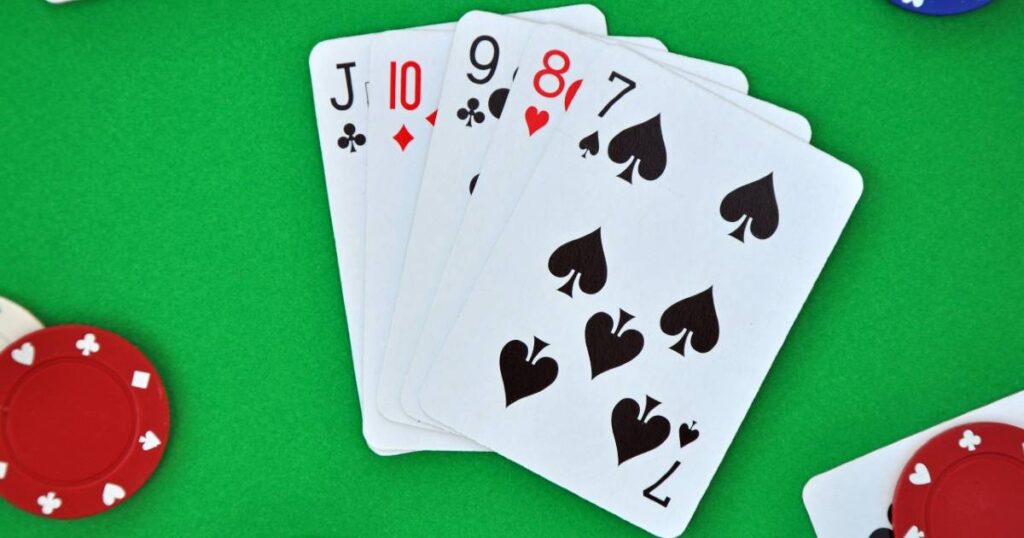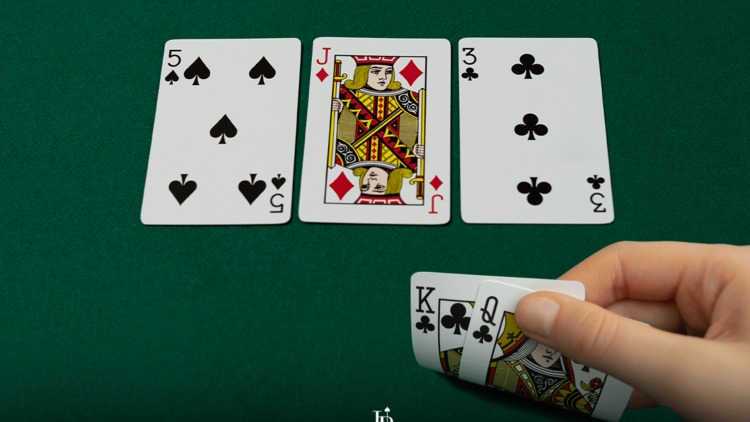Understanding Straights in Poker
In poker, a Straight is a hand consisting of five consecutive numerical cards, regardless of their suits. For instance, a hand like A♠ K♦ Q♥ J♣ 10♠ forms a Straight because the cards are in sequential order: Ace (A), King (K), Queen (Q), Jack (J), and 10. The suits (Spades, Diamonds, Hearts, Clubs) do not influence the validity of a Straight; only the numerical sequence matters. A Straight can start from any rank, such as 5♣ 4♥ 3♠ 2♦ A♣ or go up to 10♥ 9♦ 8♠ 7♣ 6♠. The highest possible Straight is A♠ K♦ Q♥ J♣ 10♠, also known as “Broadway,” while the lowest is A♣ 2♦ 3♠ 4♥ 5♣, commonly referred to as a “wheel” or “bicycle.”
Hierarchy of Poker Hands
In the hierarchy of poker hands, a Straight ranks fifth among all possible hands. It is less potent than a Flush, Full House, Four-of-a-Kind, or Straight Flush, but it can still win significant pots if played strategically. In Texas Hold’em, understanding how and when to play a Straight is crucial for maximizing your chances of winning.
Ways to Play Poker and Enjoy Straights
If you’re interested in playing poker for profit or leisure, you have several options:
- Live Poker at Local Casinos: Live poker games are popular in local casinos, with cash games often starting at ₱58/117. Texas Hold’em is the most common variant, and compared to online games, live stakes are generally softer and more beatable.
- Home Poker Games: Participating in home poker games can be both enjoyable and profitable, especially if you have access through connections or invitations. The relaxed environment allows for casual play while still offering the potential for significant wins.
- Online Poker Platforms: Exploring online poker sites dedicated to various formats like NLHE, PLO, PLO6, Mixed Games, etc., is another great option. Stakes range from ₱0.59/1.17 up to substantial amounts like ₱29274/58549 or higher, providing a wide range of opportunities to test your skills.
- Reputable Online Poker Casinos: Researching reputable online poker casinos, such as swerte99, ensures fair play through verified RNGs (Random Number Generators). Licensed sites provide accurate winning probabilities for poker and other games, offering a secure environment for players aiming for rewarding hands like a Straight.
Poker Straight Odds and Probabilities
Understanding the mathematics behind poker is crucial for long-term success, especially when it comes to drawing to a Straight. In a standard 52-card deck, there are 10,200 distinct ways to form a Straight. While this number may seem large, it’s essential to consider how this applies in games like Texas Hold’em, where you receive two hole cards and the board provides five community cards.
In Texas Hold’em, the odds of completing a Straight when all community cards swerte99 are revealed are approximately 4.62%, translating to odds of around 20.6-to-1 against drawing a Straight.
Specific Straight Draws: Odds and Strategies
- Gutshot Straight Draw (Four Outs):
- Turn Probability: Approximately 8.51%
- River Probability (if not completed on the turn): Approximately 8.70%
- Open-Ended Straight Draw (Eight Outs):
- Turn Probability: Approximately 16.04%
- River Probability (if not completed on the turn): Approximately 16.52%
- Straight Flush Draw (Four Outs):
- Turn Probability: Approximately 0.18%
- River Probability (if not completed on the turn): Approximately 0.18%
Knowing these probabilities helps you make informed decisions about whether to pursue a Straight draw based on the current stage of the hand. Whether you’re playing cash games or tournaments, understanding when to effectively draw to a Straight is a fundamental component of optimal poker strategy.

Strategies for Straights in Cash Games
In cash games, players are often more willing to take risks compared to tournament settings, where survival is paramount unless you have a big stack to apply pressure. Here’s an optimal strategy for playing Straights in cash games:
Calculate Pot Odds
Before committing chips to a Straight draw, assess your pot odds. Compare your bet size to the total pot size, including your opponents’ bets. If the potential reward (pot odds) is greater than the cost of your bet, it can be profitable to chase your Straight.
- Example: Playing No-Limit Texas Hold’em with ₱5854 stacks, the pot is ₱1170. You need one more card for your Straight draw, and your opponent bets ₱585. Your pot odds are (₱585 + ₱1170) / ₱585 = 3:1. If your chances of completing the Straight are better than 3:1, it’s a favorable call.
Consider Implied Odds
In cash games, factor in implied odds, which include potential future bets if you complete your Straight and extract more value from opponents.
- Example: Holding 7♠8♠ on a flop of 9♣10♦2♠ gives you an open-ended Straight draw. Your opponent bets ₱1170 into a ₱1756 pot. Even if your current pot odds aren’t ideal, anticipate that hitting your Straight on the turn or river may prompt further betting, potentially increasing the pot size. This additional value should influence your decision to call.
Be Aware of Board Texture
The texture of community cards significantly influences decisions. A coordinated board—where cards are in sequence or of the same suit—enhances the value of your Straight draw.
- Example: If the flop shows J♠Q♠2♣ and you hold K♦10♠, you have both an open-ended Straight draw and a flush draw. With such a coordinated board, your Straight draw gains substantial equity, making it a potent draw regardless of your opponents’ holdings.
Understanding and applying these principles can help you make informed decisions about chasing Straights in cash games, where risk tolerance and potential profitability are key considerations.
Straights in Tournament Poker
In tournament poker, where the primary goal is to maximize your return on investment by accumulating chips and surviving, pursuing Straight draws requires a strategic approach tailored to the tournament dynamics.
Consider Chip Stack and Tournament Stage
Evaluate your chip stack relative to the blinds and antes. Early in the tournament with a deeper stack, you have more flexibility to speculate on Straight draws. However, as blinds escalate and your stack diminishes relative to them, the odds required to justify chasing a Straight draw become stricter, particularly as you near critical stages like the bubble.
Take Calculated Risks
In tournament play, survival is paramount. Preserving your chip stack is crucial, especially in crucial stages like approaching the bubble or aiming for the final table. Avoid committing a substantial portion of your stack to a Straight draw unless the odds heavily favor your chances.
Utilize Tournament Dynamics
Near the bubble, players tend to play conservatively to secure a cash finish. Exploit this by selectively aggressing with Straight draws when opponents are less likely to call big bets without strong hands.
- Example Hand in a Tournament: Imagine you’re in a tournament with increasing blinds. Holding 9♠10♠ and seeing a flop of 7♣8♦K♠, you have an open-ended Straight draw but a dwindling chip stack. In this scenario, folding may be prudent, especially if the pot odds aren’t favorable or if facing aggression. However, if your opponent appears weak, consider semi-bluffing to potentially steal the pot.
Adapting your strategy based on tournament dynamics, stack size, and opponent tendencies is essential when deciding whether to pursue Straight draws in tournament poker. Balancing risk and reward becomes increasingly critical as the tournament progresses toward its decisive stages.
Poker Game Variations and Straights
Understanding how Straights function across different poker variants is crucial, as rules can vary significantly.
- Texas Hold’em: A Straight consists of five consecutive cards from a player’s hand and the community cards. Players can use any combination of their hole cards and the community cards to form a Straight. Aces can be high (A-K-Q-J-10) or low (A-2-3-4-5, known as the “wheel”).
- Seven-Card Stud: Straights can only use Aces as high cards. The highest possible Straight is 10-J-Q-K-A of different suits. Players must strategize based on both face-up and face-down cards when forming Straights.
- Razz: The lowest possible Straight (A-2-3-4-5, or the “wheel”) is the best hand. Straights do not count against your hand, so lower cards are preferable.
- Omaha: Players receive four hole cards and must use exactly two of them with three community cards to form a Straight. Aces can be high or low as in Texas Hold’em.
- Five-Card Draw: A Straight is formed by selecting five consecutive cards from the player’s hand. Aces can be high (A-K-Q-J-10) or low (A-2-3-4-5).
- Short Deck Poker: Cards from 2 to 5 are removed from the deck, making Straights easier to form. Any five consecutive cards can form a Straight due to the reduced deck size.
- Triple Draw Lowball: Aces are high, so the lowest possible Straight is A-2-3-4-5. Players can improve their Straights over multiple drawing rounds.
Each variant brings unique strategies and considerations when playing Straights, from utilizing hole cards effectively in Texas Hold’em to aiming for low Straights in Razz. Understanding these nuances enhances your ability to play each game optimally.
The Most Famous Straight in Poker History
The 1987 World Series of Poker (WSOP) Main Event hand between Johnny Chan and Erik Seidel remains a legendary moment in poker history, famously depicted in the movie Rounders. Here’s a recount of that pivotal hand:
Johnny Chan held J9 suited and flopped a Straight, while Erik Seidel hit top pair with a weak kicker. Seidel re-raised Chan’s flop bet, which Chan called. The turn was uneventful, with both players checking. Chan’s trap was set, and Seidel pushed all-in on the river, only to be snap-called by Chan holding the nuts—the unbeatable Straight.
This real-life scenario highlights how strategic betting with a flopped Straight can lead to significant wins, cementing a player’s reputation in the poker world. While your Straight may not replicate Johnny Chan’s triumph, mastering swerte99 skill and optimal strategy, possibly with guidance from swerte99, can certainly lead to landing substantial pots in your own poker journey!

